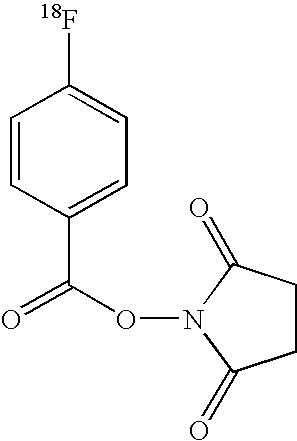Radiolabelling Method Using Polymers
a polymer and polymer technology, applied in the field of radioisotopically labeled imaging agent compositions, can solve the problems of relatively poor swelling ability of polystyrene-based solid supports, compounding efficiency, etc., and achieves poor swelling ability, efficient reaction, and lowered recovery
Inactive Publication Date: 2008-12-11
GACEK MICHEL +2
View PDF3 Cites 25 Cited by
- Summary
- Abstract
- Description
- Claims
- Application Information
AI Technical Summary
Benefits of technology
[0007]The present method represents a middle point between the kinetic advantages of using entirely solution phase chemistry with its consequent poor purity profile, and solid phase chemistry, with slower kinetics but better purity. The present invention uses polymers which are macromolecules soluble either in organic or aqueous solution. This is essentially a surrogate resin, where all subsequent radiolabelling is carried out in the solution phase rather than the solid phase. The subsequent purification of the desired radioactive imaging agent from the macromolecule can be achieved either chromatographically or through precipitation / extraction. The soluble polymer approach of the present invention is expected to be particularly useful for reactions in which the precursor is sterically bulky, and hence would be less able to access the internal surfaces of the resin.
Problems solved by technology
Additionally the problem of getting efficient reaction is compounded by the relatively poor swelling ability of polystyrene-based solid supports in the polar organic solvents, such as acetonitrile, generally used for radiofluorination reactions.
Method used
the structure of the environmentally friendly knitted fabric provided by the present invention; figure 2 Flow chart of the yarn wrapping machine for environmentally friendly knitted fabrics and storage devices; image 3 Is the parameter map of the yarn covering machine
View moreImage
Smart Image Click on the blue labels to locate them in the text.
Smart ImageViewing Examples
Examples
Experimental program
Comparison scheme
Effect test
example 1
Synthesis of 18F-DOPA
[0178]This is a prophetic Example.
[0179]The approach which would be used is given in FIG. 1:
[0180]The iodonium salts would be prepared by the methods of Pike et al [JCS Perkin Trans., 2043 (1998)] and as described in WO 2004 / 056400. The DOPA precursors can be obtained as described by Bolton [J.Lab.Comp.Radiopharm., 45, 485-528 (2002)].
the structure of the environmentally friendly knitted fabric provided by the present invention; figure 2 Flow chart of the yarn wrapping machine for environmentally friendly knitted fabrics and storage devices; image 3 Is the parameter map of the yarn covering machine
Login to View More PUM
| Property | Measurement | Unit |
|---|---|---|
| molecular weight | aaaaa | aaaaa |
| molecular weight | aaaaa | aaaaa |
| molecular weight | aaaaa | aaaaa |
Login to View More
Abstract
The present invention provides a method for the preparation of radioisotopically-labelled imaging agent compositions. The method uses precursors which are bound to soluble polymers, so that the radiolabelling reaction is carried out in solution. Also described are radiopharmaceutical compositions, automated versions of the radiolabelling method and disposable cassettes for use in the automated method.
Description
FIELD OF THE INVENTION[0001]The present invention provides a method for the preparation of radioisotopically-labelled imaging agent compositions. The method uses precursors which are bound to soluble polymers, so that the radiolabelling reaction is carried out in solution. Also described are radiopharmaceutical compositions, automated versions of the radiolabelling method and disposable cassettes for use in the automated method.BACKGROUND TO THE INVENTION[0002]In the synthesis of radiopharmaceuticals such as 2-[18F]-fluoro-2-deoxyglucose (18F-FDG), the yield of the final product is limited by the short half-life of the radioisotope (110 mins for 18F). Hence, the synthesis time is of crucial importance to the yield. The radiolabelling reaction is typically based on the reaction of a non-radioactive precursor with a supply of the radioisotope, wherein the precursor is present in large chemical excess. When such radiolabelling reactions are performed in solution, the consequence is tha...
Claims
the structure of the environmentally friendly knitted fabric provided by the present invention; figure 2 Flow chart of the yarn wrapping machine for environmentally friendly knitted fabrics and storage devices; image 3 Is the parameter map of the yarn covering machine
Login to View More Application Information
Patent Timeline
 Login to View More
Login to View More Patent Type & Authority Applications(United States)
IPC IPC(8): A61K51/06A61K51/08
CPCA61K51/0402A61K51/1282C07B59/001
Inventor GACEK, MICHELPRIEBE, HANNOOSBORN, NIGEL JOHN
Owner GACEK MICHEL
Features
- R&D
- Intellectual Property
- Life Sciences
- Materials
- Tech Scout
Why Patsnap Eureka
- Unparalleled Data Quality
- Higher Quality Content
- 60% Fewer Hallucinations
Social media
Patsnap Eureka Blog
Learn More Browse by: Latest US Patents, China's latest patents, Technical Efficacy Thesaurus, Application Domain, Technology Topic, Popular Technical Reports.
© 2025 PatSnap. All rights reserved.Legal|Privacy policy|Modern Slavery Act Transparency Statement|Sitemap|About US| Contact US: help@patsnap.com



